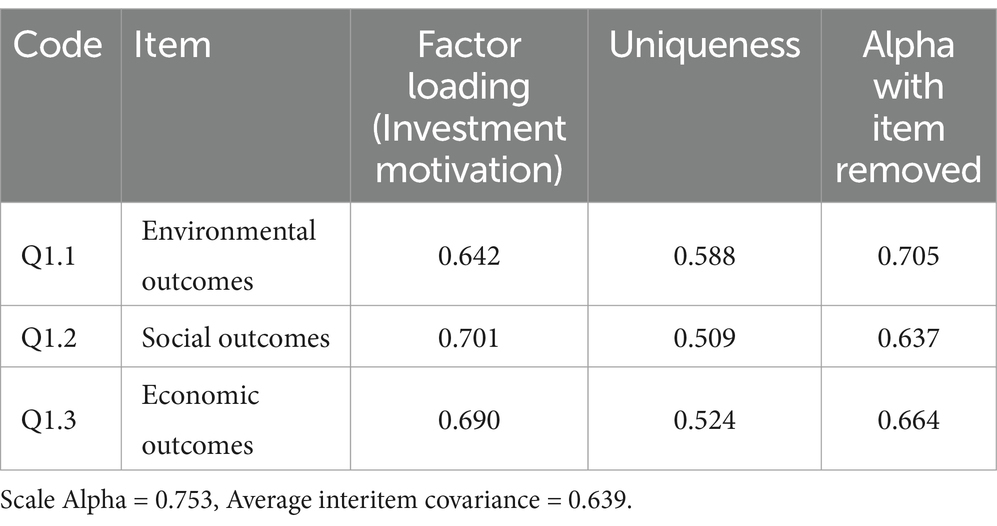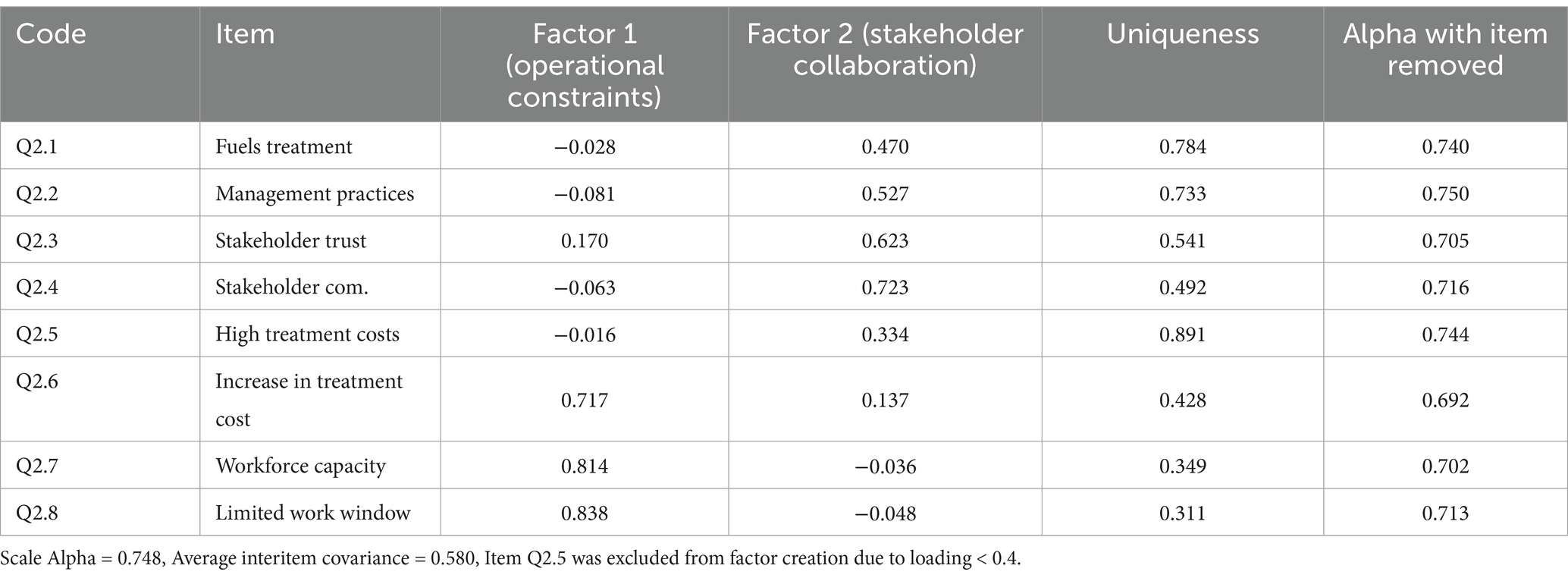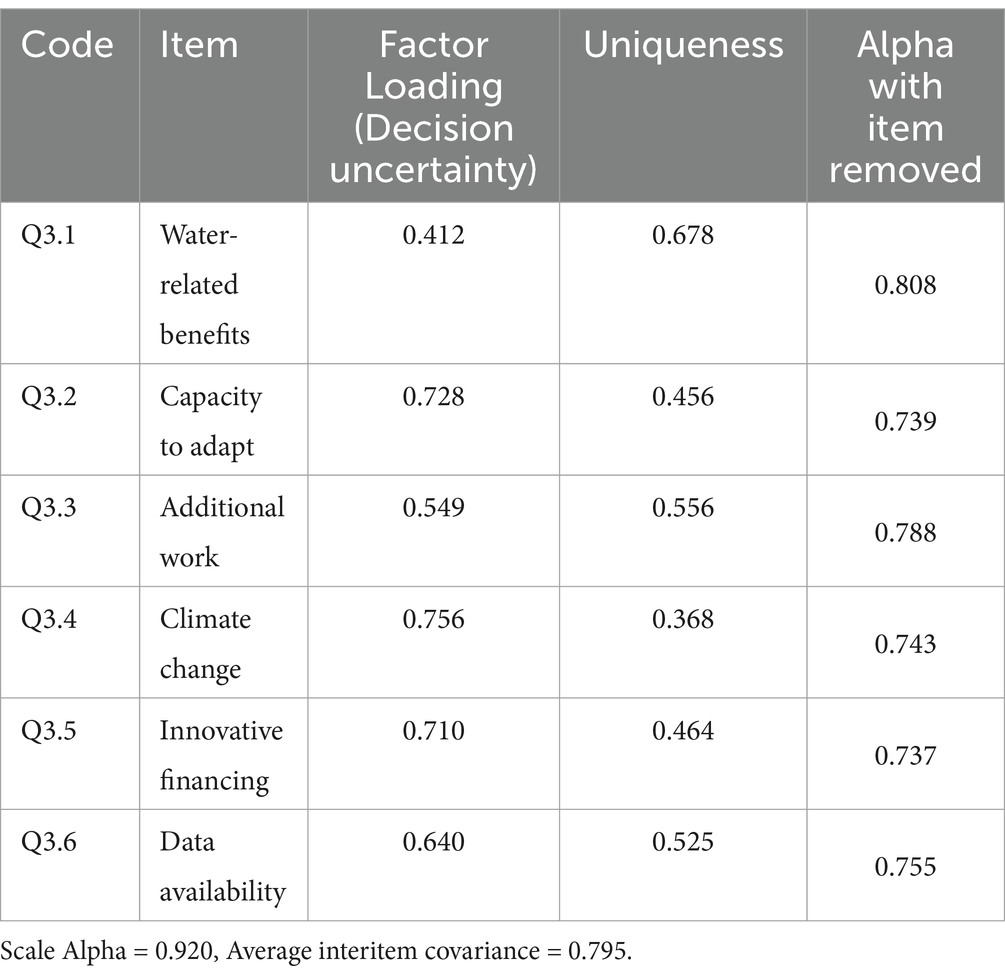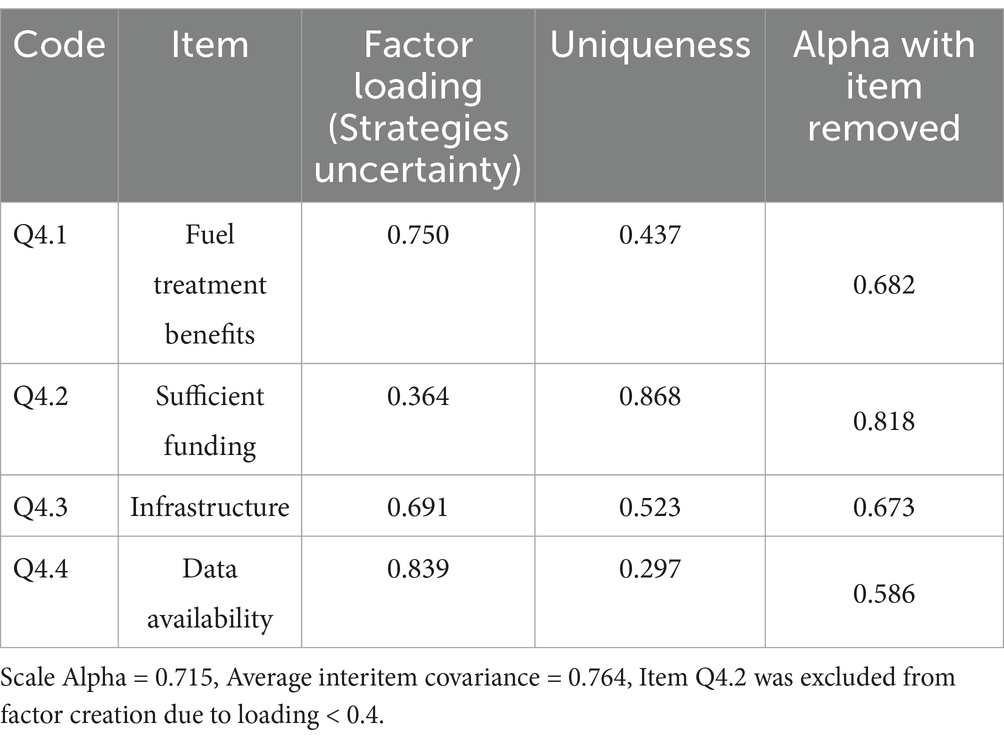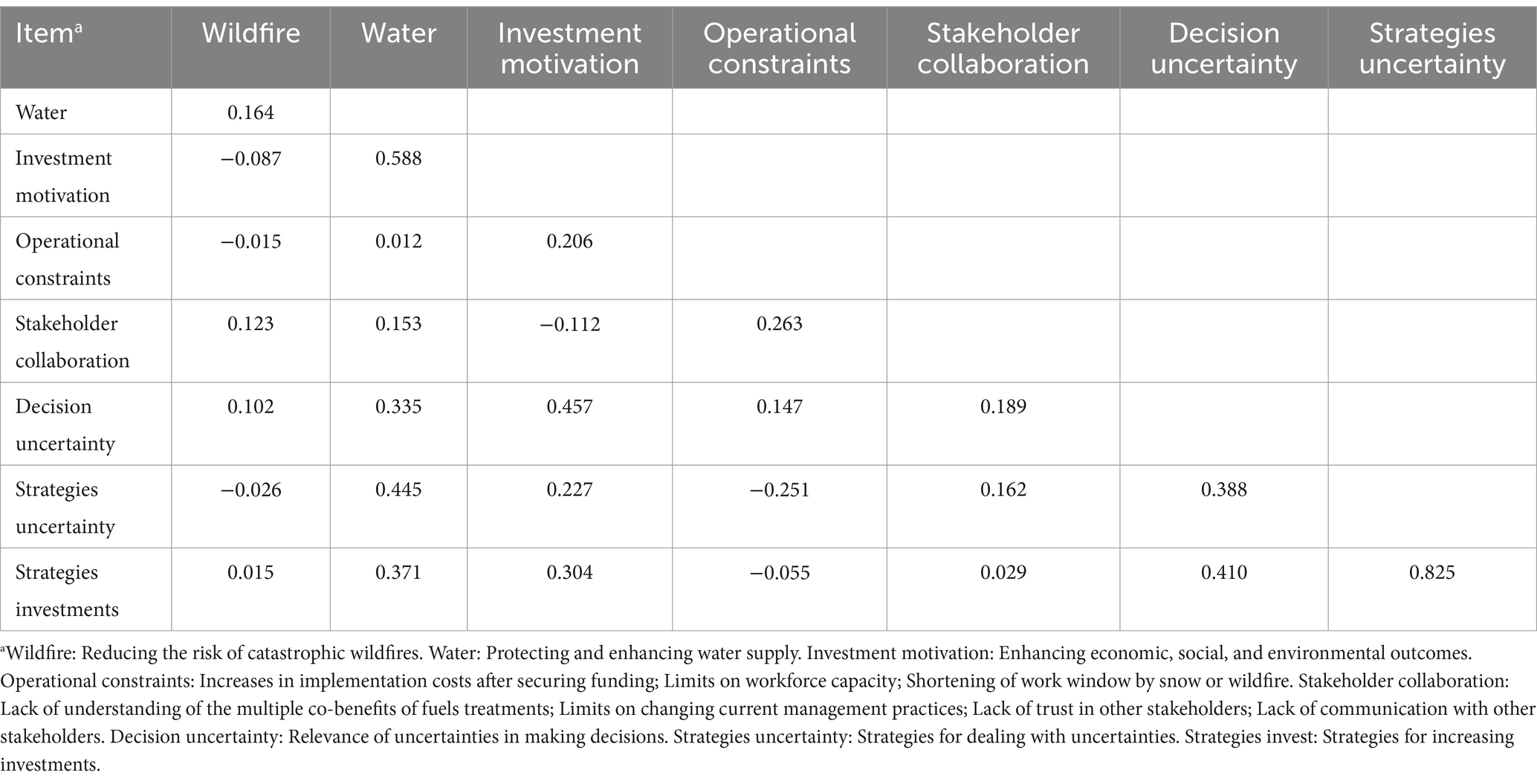- 1Department of Earth System Science, University of California Irvine, Irvine, CA, United States
- 2Khoury College of Computer Sciences, Northeastern University, Oakland, CA, United States
- 3Department of Geography and Regional Studies, Klagenfurt University, Klagenfurt am Wörthersee, Austria
- 4Department of Population Health and Disease Prevention, University of California Irvine, Irvine, CA, United States
- 5Sierra Nevada Research Institute, University of California Merced, Merced, CA, United States
- 6Department of Civil and Environmental Engineering, University of California Berkeley, Berkeley, CA, United States
Introduction: Large-scale investments in restoring California’s forested watersheds are imperative for conserving biodiversity, enhancing water quality, and mitigating the future impacts of climate change. This study explores the underlying incentives, major challenges, and potential strategies associated with such investments.
Methods: An online survey was administered to 43 experts in the field to gather their insights on forest watershed restoration investments. The collected responses were then analyzed using a combination of confirmatory factor analysis and regression analysis to elucidate patterns and relationships.
Results: The analysis revealed that key environmental outcomes, such as reducing wildfire risks and protecting water supplies, are the principal motivators driving investment. At the same time, significant barriers emerged, including high costs, limited workforce capacity, and insufficient trust among stakeholders. The study also identified a series of effective strategies to overcome these obstacles, such as repositioning forest restoration as an infrastructure investment and clearly demonstrating its ecological, social, and economic benefits.
Discussion: Overall, the findings underscore the need for more flexible funding frameworks, enhanced stakeholder engagement, and improved data infrastructures. By addressing these elements, policymakers and practitioners can pave the way for more resilient and sustainable forested-watershed ecosystems in California.
Highlights
• Financial and workforce constraints are primary barriers to investing in restoration, with climate, outcome, and operational uncertainties also important.
• Enumeration of environmental and economic benefits of restoration can bolster stakeholder collaboration and investments.
• Wildfire risk reduction is a primary motivator for investing in forest restoration, with water and environmental co-benefits also important.
• Stakeholder collaboration, supported by credible data and information, can lower barriers to advancing multi-benefit forest restoration.
1 Introduction
Forested watersheds in California provide vital ecological, economic, and social benefits that contribute to environmental sustainability. These watersheds support diverse species and habitats, aiding in biodiversity conservation and maintaining ecosystem stability (Sun and Vose, 2016; Saksa et al., 2017). Additionally, they play a significant role in climate change mitigation by acting as carbon sinks, absorbing atmospheric CO₂ and thereby reducing atmospheric greenhouse gas concentrations (Giles-Hansen et al., 2021; Layton and Ellison, 2016). Beyond their climate-related benefits, forested watersheds contribute to water quality by filtering contaminants, stabilizing stream banks, and minimizing sediment and nutrient runoff (East et al., 2021). Riparian buffers—vegetated strips adjacent to water bodies—enhance these functions by reducing erosion and filtering pollutants before they enter waterways (Prepas et al., 2008; Amatya and Trettin, 2020). However, disturbances such as wildfires and logging disrupt these processes, increasing sediment runoff and altering nutrient cycles, potentially affecting downstream ecosystems (Bart et al., 2020; Ku et al., 2024).
In addition to ecological benefits, forested watersheds contribute to regional economic stability by supporting industries such as agriculture, forestry, fisheries, and recreation. Healthy watersheds improve agricultural productivity by preserving soil quality and regulating water availability (Maridi et al., 2014). They also bolster economic activities like hiking, fishing, and wildlife tourism, which generate revenue for local communities and stimulate job creation (Srivastava et al., 2020). Furthermore, forested watersheds influence hydrologic cycles by enhancing water infiltration, reducing surface runoff, and mitigating soil erosion (Meli et al., 2024). Their role in atmospheric moisture redistribution, facilitated through evapotranspiration patterns, further supports precipitation recycling (Ellison et al., 2012; Ellisson et al., 2017). Maintaining these benefits requires strategic watershed management to ensure the sustained availability of resources for ecological and economic activities.
Despite their importance, forested watersheds in California face mounting challenges, including climate change, urbanization, and resource extraction. Increasing wildfire frequency and altered precipitation patterns have intensified drought conditions, heightening risks to watershed stability (Saksa et al., 2017; Tang and Adesina, 2022). Prolonged drought periods influence runoff timing and water availability, impacting both natural ecosystems and human populations. Additionally, urban expansion and industrial development contribute to habitat fragmentation, pollution, and shifts in hydrologic processes (Walsh et al., 2012). Changes to land cover and water cycles from resource extraction activities further stress watershed health (Akhtar et al., 2021). Given the complexity of interacting environmental stressors, a comprehensive understanding of watershed dynamics is necessary to develop effective adaptation and restoration measures (Merriam et al., 2016). Successful restoration initiatives have the potential to reestablish ecological functions, improve water quality, and support biodiversity conservation while simultaneously fostering resilience within local communities (Li et al., 2018; Bismihayati, 2023).
Several restoration approaches, including mechanical thinning, mastication, and controlled burning, aim to address hydrologic and ecological challenges associated with watershed degradation (North et al., 2021). Thinning to reduce fuels enhances forest health by mitigating fire risks, with recent costs in the Central Sierra Nevada averaging $3000 per hectare or more (Guo et al., 2023), at least double those reported a decade ago (Page-Dumroese et al., 2017; Ganzlin et al., 2016). Mastication efficiently reduces combustible material and sedimentation risks but requires additional management to handle debris accumulation, generally costing between $750 and $2000 per hectare (Ramberg et al., 2023; Barros et al., 2018). Controlled burning serves as a cost-effective strategy to reduce fire hazards, restore habitats, and promote ecosystem regeneration, however, costs in the Sierra Nevada are approaching those for thinning, again much higher than costs reported a decade ago (Eales et al., 2016; Ryu et al., 2017). However, financial constraints, regulatory barriers, and long project timelines frequently hinder the implementation of restoration efforts, limiting investments (Eriksson et al., 2025; Meli et al., 2017). Potential solutions include innovative financial models such as public-private partnerships and payments for ecosystem services, which aim to facilitate funding for restoration projects (Lamb, 2018).
Regulatory challenges present additional obstacles to watershed restoration. Complex permitting processes, lengthy approval timelines, and inconsistent policies across jurisdictions create uncertainty for stakeholders and delay implementation (Hessburg et al., 2021). Some environmental regulations require supplementary assessments, further increasing project costs and administrative burdens. Simplifying permitting procedures and improving policy coherence could help streamline restoration efforts. Technical limitations also impact restoration success, as the lack of standardized methodologies affects project consistency and outcome measurement (Jones et al., 2021). Limited access to advanced technological tools, such as remote sensing and modeling applications, restricts practitioners’ ability to plan restoration projects effectively (Stephens et al., 2023). Furthermore, inadequate stakeholder coordination and low community engagement hinder restoration adoption, despite evidence indicating that participatory approaches and effective communication strategies enhance project acceptance (Guariguata and Brancalion, 2014).
While prior research has explored the ecological and economic benefits of forested watershed restoration, investment decisions remain an understudied aspect. Studies suggest that financial mechanisms, regulatory efficiency, and advancements in technology influence restoration investment trends (Burton and Macdonald, 2011; Won and Song, 2024; Burnett et al., 2018). Emerging geospatial technologies, including remote sensing, GIS mapping, and predictive modeling, have improved restoration planning, allowing for more accurate assessments of land cover changes, fire risks, and hydrologic fluctuations (Jones et al., 2021; Stephens et al., 2023). Additionally, integrating participatory approaches with technological applications may enhance stakeholder engagement and facilitate long-term investment. Despite existing literature, key factors shaping investment decisions in watershed restoration require further exploration. To address this gap, this study examines (1) financial, regulatory, technical, and social barriers to investing in forested watershed restoration in California, (2) uncertainties surrounding financial returns, climate impacts, and data availability, and (3) strategies to mitigate investment barriers and uncertainties.
2 Materials and methods
2.1 Data collection
Between April and June 2024, we conducted an online survey to examine expert perceptions regarding the restoration of forested watersheds in California (Appendix 1). The survey aimed to identify key challenges, uncertainties, and strategies influencing investment decisions in watershed restoration. To ensure a diverse and representative sample, participants were recruited through professional networks and organizations specializing in natural resource management across the state. The target audience included experts from government agencies, non-profit organizations, private-sector entities, and academic institutions. The survey was designed using Microsoft Forms and disseminated through multiple channels, including printed questionnaires with QR codes and direct email outreach, to maximize accessibility and participation. Before launching the survey, a pilot test was conducted with a group of experts to refine questions and validate the reliability of the collected data. Participants were fully informed of the study’s purpose, and their consent was obtained prior to participation. To protect respondent confidentiality, all survey responses were anonymized. Ethical approval for this study was secured from the University of California Merced Institutional Review Board.
In distributing the survey, 150 printed copies of the questionnaire containing QR codes were shared with attendees of the Governor’s Wildfire and Forest Resilience Task Force’s Southern California Regional meeting on April 4, 2024. Additionally, an email invitation was sent to 101 identified stakeholders on May 17, 2024, by which time 9 responses had been received. By May 22, 15 additional responses were collected. To encourage further participation, a follow-up reminder was sent on May 24, resulting in an additional 19 responses by June 13. Throughout data collection, responses were periodically reviewed to maintain quality and completeness, ensuring accurate insights into expert perspectives on watershed restoration investment.
2.2 Measurements
The questionnaire was structured around five main topics: (I) Reasons for investing, (II) Barriers to investment, (III) Uncertainties in decision-making, (IV) Importance of strategies for addressing uncertainties, and (V) Relevance of strategies for increasing investments (Table 1). Each of these topics contained sub-questions presented in a matrix format, measured on a seven-point Likert scale with a neutral middle alternative. Three different sets of non-numerical anchors were used: Q1 and Q4 measured importance (1 = Not at all important, 2 = Low importance, 3 = Slightly important, 4 = Neutral, 5 = Moderately important, 6 = Very important, 7 = Extremely important), Q2 measured barriers (1 = Not a barrier, 2 = Minor barrier, 3 = Somewhat barrier, 4 = Neutral, 5 = Considerable barrier, 6 = Major barrier, 7 = Extreme barrier), and Q3 and Q5 measured relevance (1 = Not at all relevant, 2 = Low relevance, 3 = Slightly relevant, 4 = Neutral, 5 = Moderately relevant, 6 = Very relevant, 7 = Extremely relevant). Additionally, the questionnaire included two demographic questions measuring gender and the number of years the respondent had worked with natural resources.
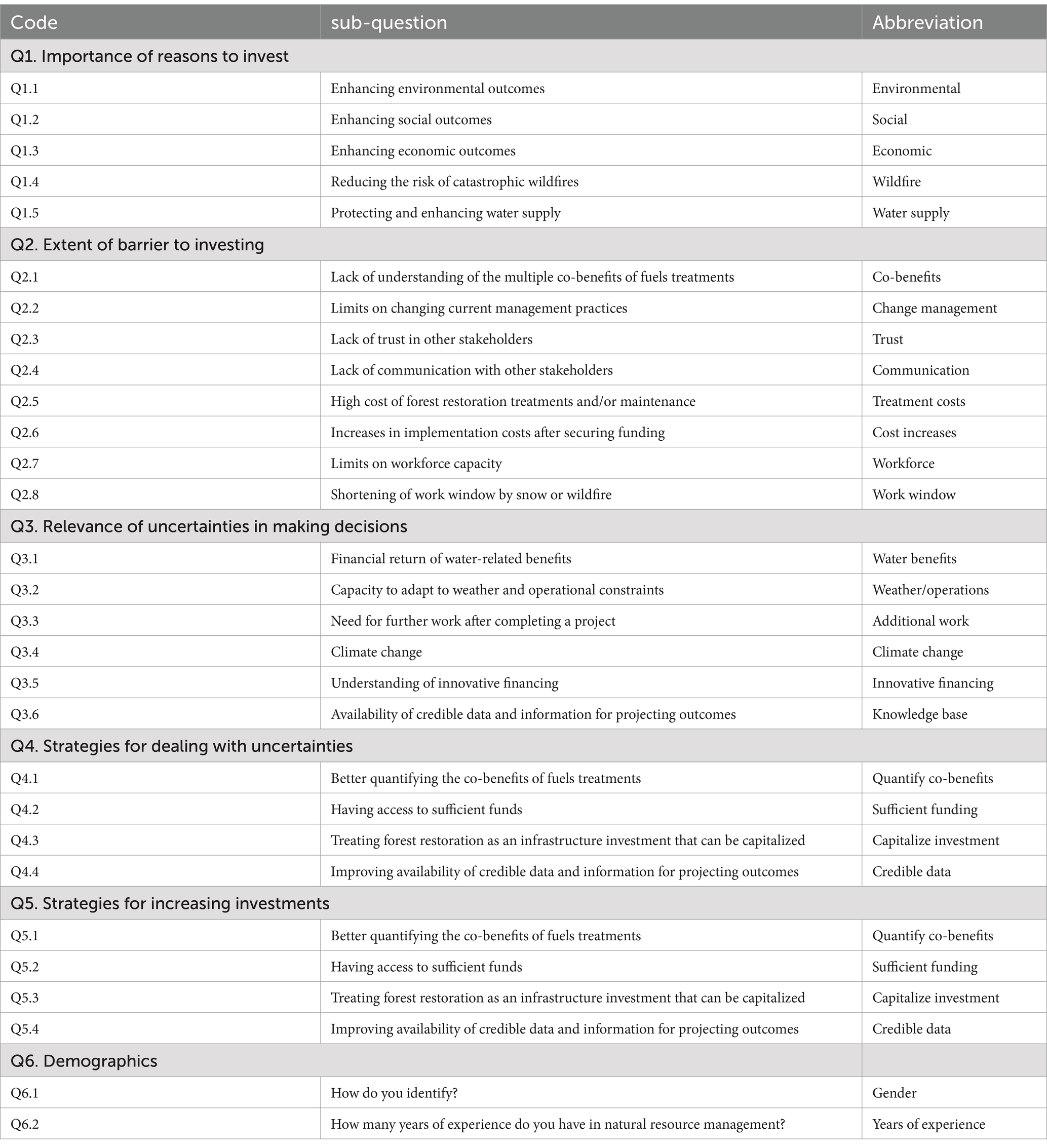
Table 1. Summary of sub-questions and their abbreviations for key survey questions regarding forested watershed restoration.
2.3 Analysis
Following data collection, descriptive statistics (frequencies, percentages, and means) were calculated to identify response patterns. Confirmatory factor analysis was applied to generate factors representing respondent perceptions across sub-questions from questions 1 to 5. The reliability of latent constructs was assessed using Cronbach’s alpha, while the Kaiser criterion (k > 1) determined their dimensionality. Factor loadings above 0.4 guided item retention (Hair and Sarstedt, 2019; Nunnally, 1994). A correlation matrix and linear regression model were then employed for further analysis, with Microsoft Excel used for data cleaning and descriptive statistics, and Stata for all other analytical procedures.
To explore barriers, uncertainties, and strategies in watershed restoration, this study applies Factor Analysis, a statistical method that condenses a large set of variables into underlying factors, revealing patterns and relationships within the data (Steel et al., 2022). This approach identifies latent constructs that shape expert opinions, offering insight into key factors influencing investment in forested watershed restoration in California (Vogler et al., 2015). By uncovering these patterns, the analysis provides a structured understanding of the challenges and opportunities central to sustainable watershed management.
3 Results
We received responses from 43 participants. Of these, 72% identified as men, 23% as women, 2% declined to specify their gender, and another 2% answered as representatives of an organization or group. Among the respondents, 32 provided information on their years of experience in the field, averaging 23.2 years (SD = ±12.5). Approximately 19% of respondents had 1–10 years of experience in forest restoration and watershed management, 22% had 11–20 years of experience, while the largest groups in the sample had 21–30 years of experience (38%). Additionally, 9% of respondents had 31–40 years of experience, while 13% of the respondents had 41–50 years of experience. Figures 1–5 summarize respondents’ perceptions and frequency distributions for the 27 sub-questions, with each assessed across a seven-point scale to capture the ranges of perceived importance, barriers, and relevance. Responses to questions are arranged by level of importance, top to bottom, in each figure. The associated raw data are available in Supplementary Table S1.
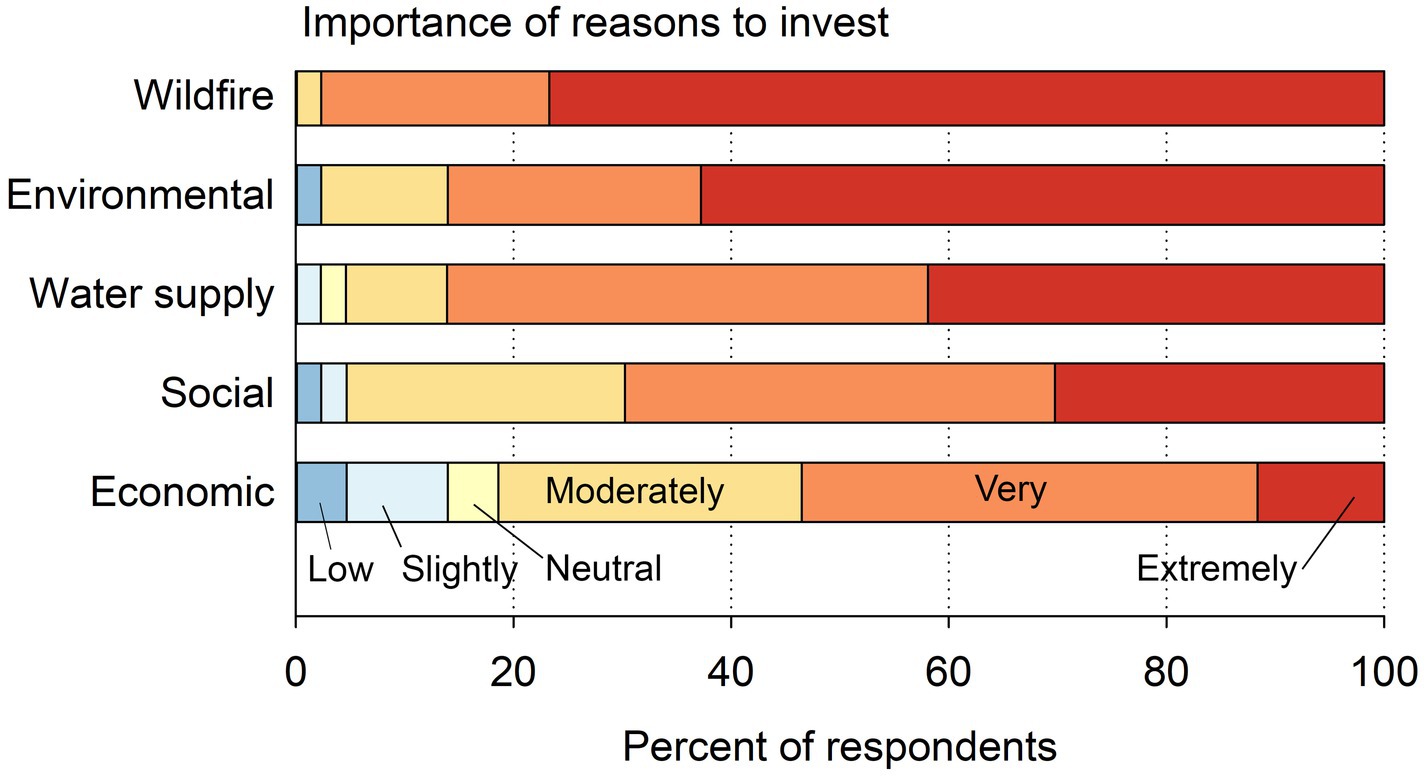
Figure 1. Frequency of responses on the importance of reasons to invest in forest restoration treatments and other measures in restoring forested watersheds (n = 43). Note that across the 5 questions no respondents selected “not at all” important.
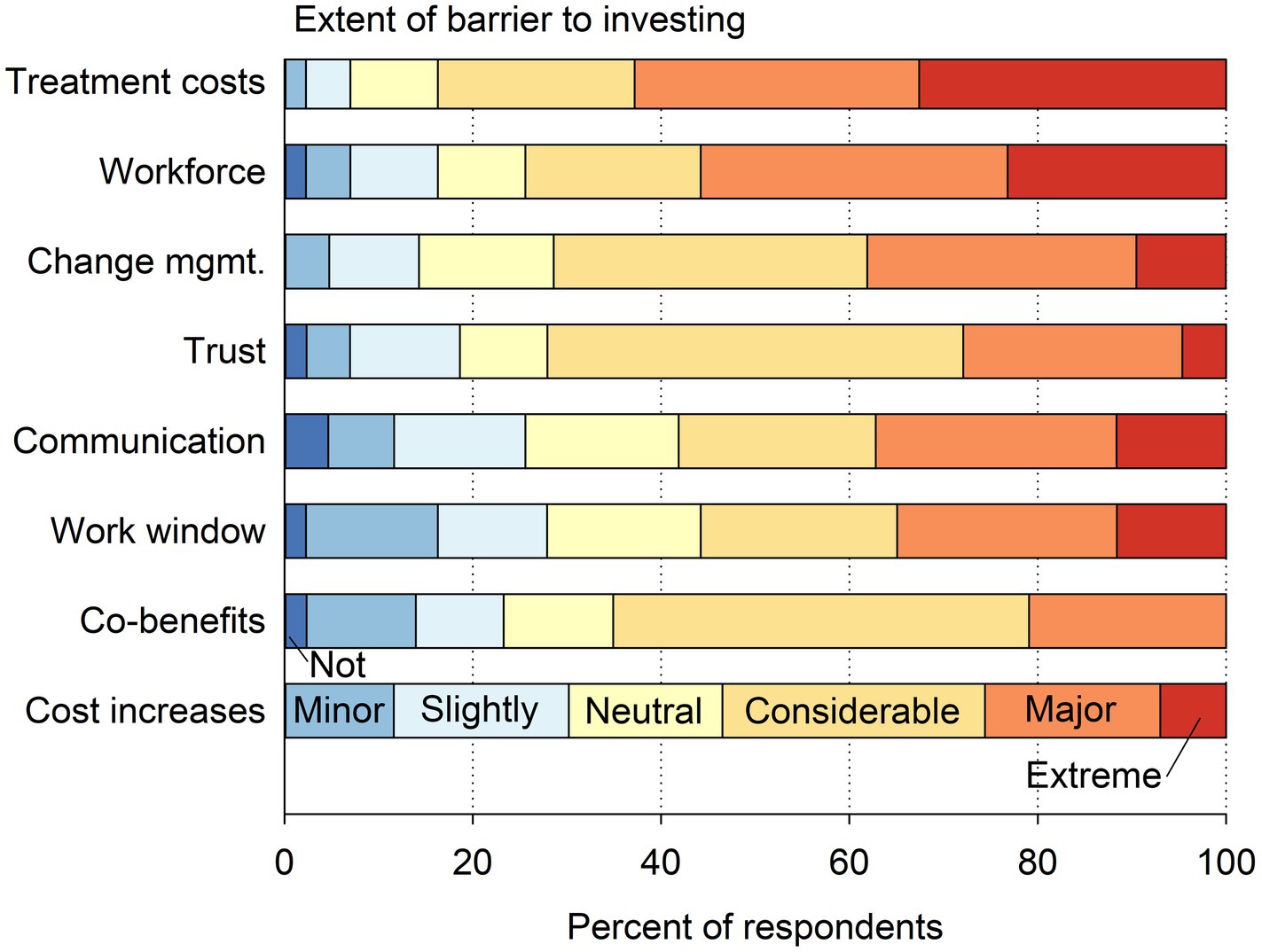
Figure 2. Frequency of responses on the barriers to investing in restoring forested watersheds (n = 43).
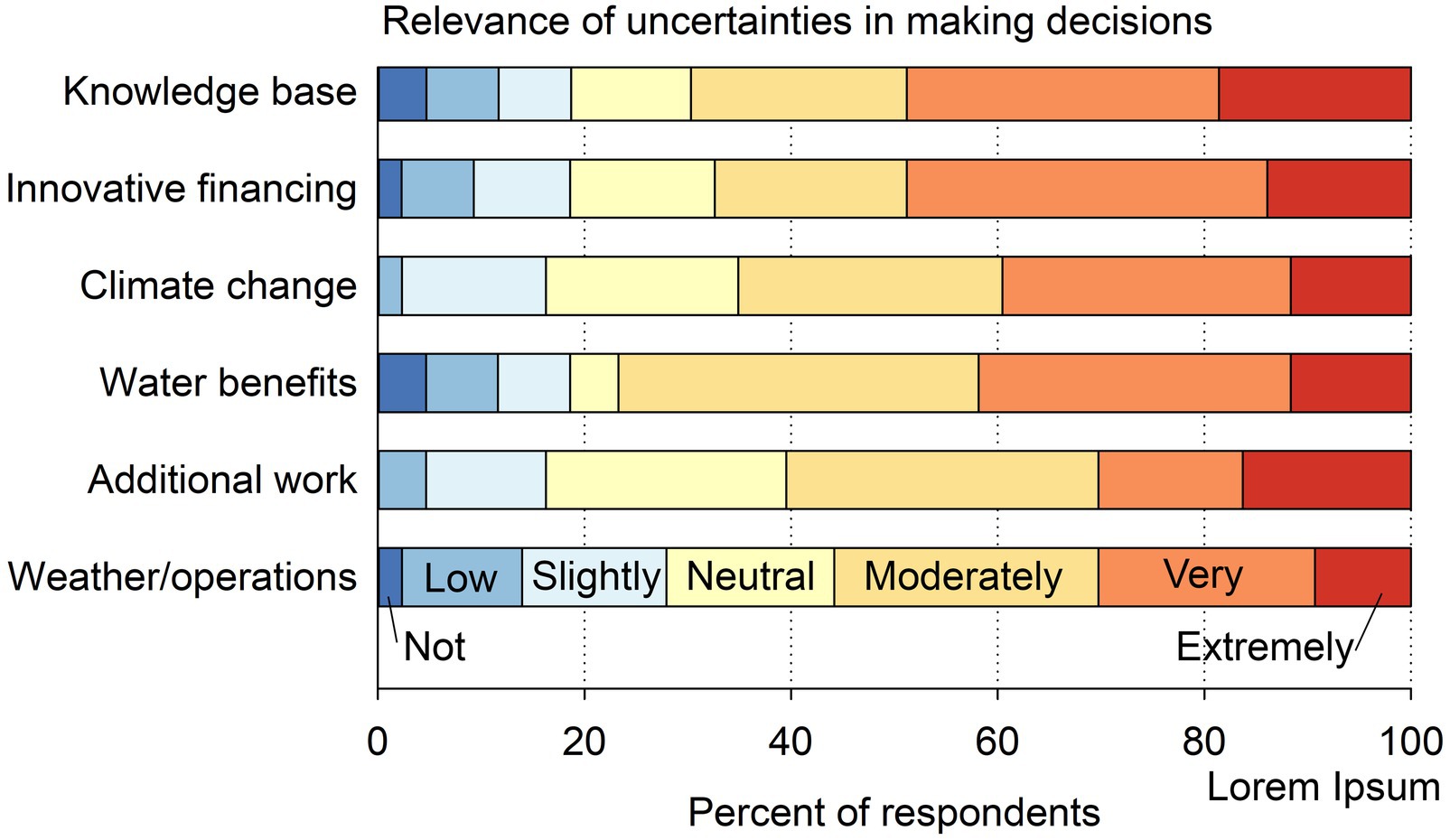
Figure 3. Frequency of responses on the relevance of uncertainties in making decisions to invest in restoring forested watersheds (n = 43).
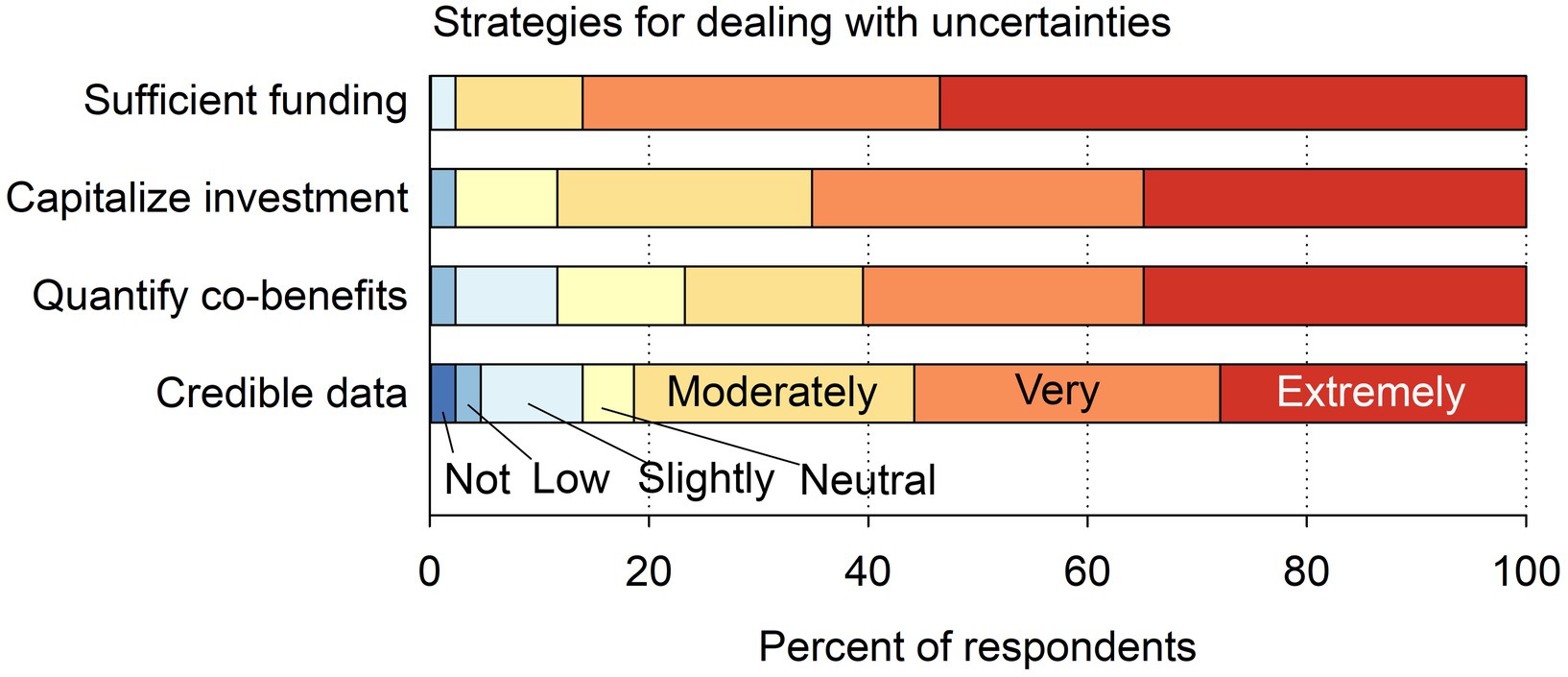
Figure 4. Frequency of responses on the importance of strategies for dealing with uncertainties around investing in restoring forested watersheds (n = 43).
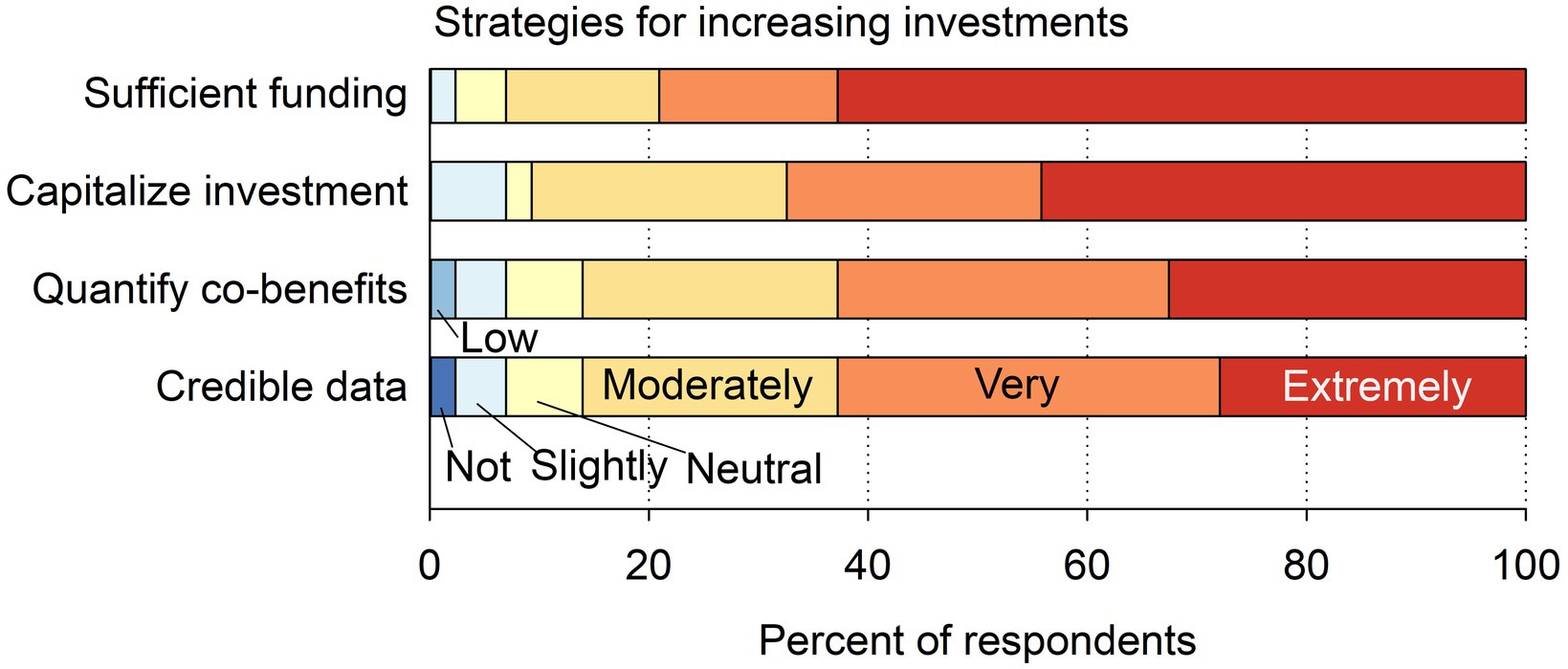
Figure 5. Frequency of responses on the importance of strategies for increasing investments in restoring forested watersheds (n = 43).
3.1 Reasons to invest in forest restoration treatments
Over 50% of the respondents answered “extremely important” or “very important” to the five questions related to reasons to invest (Figure 1). Reducing the risk of catastrophic wildfire was rated as extremely important by 77% of respondents, with another 21% rating it as very important. About 86% of responses rated enhancing environmental outcomes and water supply as extremely or very important, with just over half of the responses in the extremely important category for environmental benefits and just under 50% for water benefits. Enhancing social outcomes was rated as very or extremely important by 70% of respondents, versus 54% of respondents for economic outcomes. Including moderately important, the respective totals are 95 and 81%.
The confirmatory factor analysis indicated that respondents perceived the questions related to economic, social, and environmental outcomes as interconnected motivations for investing in forest restoration to the degree that these items could be combined into a single construct representing outcome motivation (Alpha = 0.753; Table 2). Analysis of the relationship between the outcome motivation factor solution and remaining two items measured in question 1 showed that the “Reducing the risk of catastrophic wildfires” had a probability of 0.5444 to be independent of the outcomes factor, while the corresponding probability for “Protecting and enhancing water supply” was 0.044, indicating that wildfire concerns were less related to perceived economic, social, and environmental outcomes than were water supply concerns (Table 2).
3.2 Barriers to investing in restoring forested watersheds
The survey identified several barriers to investing in the restoration of forested watersheds, with all 8 perceived as extreme, major, or moderate barriers by over half of respondents (Figure 2). The “high cost of forest restoration treatments” and “lack of workforce capacity” were perceived as the highest barriers, with over half of respondents perceiving them as extreme or major barriers. Including considerable barriers, the respective numbers are 86 and 74%. Only 7% perceived workforce capacity to be a minor or no barrier. Unwillingness to change current management practices and lack of communication with stakeholders were perceived as extreme or major barriers by 38 and 37% of respondents, respectively. Including considerable barriers, the respective values are 71 and 58%. Lack of trust in other stakeholders was perceived as an extreme or major barrier by 28% of respondents, and including a considerable barrier, the value is 72%.
While not perceived as an extreme barrier, 65% of respondents perceived a lack of understanding of water benefits and co-benefits as a “major” or “considerable barrier” to investing. Similarly, changes in treatment costs during project implementation and shortening of work window by snow or wildfire were perceived as considerable, major, or extreme barriers by 65 and 56% of respondents, respectively. The factor analysis indicated two distinct factors (Table 3). Factor 1 (Operational and financial constraints) emphasized practical and financial challenges that significantly impede restoration efforts, measured by items related to shortening of the work window by snow or wildfire, limits on workforce capacity, and increases in implementation costs after securing funding. Factor 2 (Stakeholder and communication issues) included the items lack of communication and trust among stakeholders, limits on changing current management practices, and a lack of understanding of the multiple co-benefits of fuels treatments. The high cost of restoration treatments and maintenance did not load strongly onto either factor, suggesting that while it is a recognized barrier, it might not fit neatly into the same categorical frameworks as the other barriers.
3.3 Relevance of uncertainties in making investment decisions
The survey results highlight several uncertainties that influence investment decisions, with all 6 uncertainties perceived as extremely, very, or moderately important by 56–77% of respondents (Figure 3). Understanding of innovative financing and availability of knowledge or human capital were perceived as extremely or very important by 49% of respondents, followed by financial return of water-related benefits and climate change having 40–42% of responses in these two highest uncertainty categories. Capacity to respond to operational and weather changes, and risk of additional cost for further restoration after completing planned work had 30% of responses in the extremely or very categories.
The factor analysis identified a single dominant factor—Decision Uncertainty—which encapsulates various challenges influencing restoration decisions (Table 4). This factor is characterized by concerns over water-related benefits, adaptation capacity, additional work required, climate change, innovative financing models, and data availability. Among these items, climate change (0.756) and capacity to adapt (0.728) exhibit the strongest loadings, underscoring their substantial influence on decision-making processes. Similarly, innovative financing (0.710) and data availability (0.640) highlight financial and informational constraints as key elements of uncertainty. The overall scale reliability, indicated by Cronbach’s alpha of 0.920, suggests strong internal consistency among these items. Notably, water-related benefits (0.412) show a lower loading, suggesting that while relevant, this concern might not be as influential as other factors in shaping restoration decisions.
3.4 Strategies for dealing with uncertainties
All four strategies were perceived as being extremely or very important in dealing with uncertainties around investments in watershed restoration (Figure 4). Access to sufficient funds emerged as the most critical strategy, with 53% of respondents rating it as extremely important and 33% as very important, underscoring the pivotal role of financial resources in driving investment decisions. Similarly, treating forest restoration as an infrastructure investment that can be capitalized was rated extremely important by 35% and very important by 30% of respondents. Better quantifying the co-benefits of fuels treatments was considered extremely important by 35% of respondents, very important by 26%, and moderately important by 16%. Additionally, improving the availability of credible data and information for projecting outcomes was rated as very important by 28% and extremely important by 28% of respondents.
The factor analysis identified Strategies Uncertainty as a distinct factor encompassing concerns related to restoration strategies and resource availability (Table 5). Among the items, data availability (0.839) demonstrated the strongest loading, highlighting its critical role in shaping uncertainty around strategy implementation. Similarly, fuel treatment benefits (0.750) and infrastructure limitations (0.691) were significant contributors, emphasizing challenges in assessing restoration effectiveness and resource accessibility. Notably, sufficient funding (0.364) showed a weaker loading and was excluded from factor creation due to its limited contribution to the underlying construct. The overall scale reliability, indicated by Cronbach’s alpha of 0.715, suggests moderate internal consistency, reinforcing the importance of refining strategic frameworks to enhance confidence in restoration efforts.
3.5 Strategies for increasing investments
The four strategies for increasing investments in forested watershed restoration were perceived as extremely or very important by 63–79% of respondents (Figure 5). Having access to sufficient funds emerged as the most critical strategy, with 63% of respondents rating it as extremely important and 16% as very important. No respondents rated it as being of low or no importance, though 21% did perceive it as neutral or only slightly important. The other three strategies were perceived in similar ways by respondents, with 63–67% of responses being extremely or very important.
The factor analysis identified Strategies Investment as a key factor influencing restoration funding and infrastructure decisions (Table 6). Among the items, data availability (0.808) and infrastructure (0.779) exhibit the strongest loadings, underscoring their critical role in shaping investment strategies. The substantial loading of fuel treatment benefits (0.715) suggests that stakeholders recognize the importance of effective restoration techniques in guiding investment decisions. Meanwhile, sufficient funding (0.479) displays a weaker loading, indicating that while financial resources are essential, they may not be the sole determinant of investment choices. The overall scale reliability, reflected in Cronbach’s alpha of 0.714, suggests moderate internal consistency, highlighting the need for further exploration of strategic financing mechanisms.
3.6 Correlations between items and factors
Table 7 reveals several noteworthy correlations between various factors associated with watershed restoration. There is a positive but weak correlation between reducing wildfire risk and protecting water supply (0.1643), indicating that these concerns are somewhat related. A stronger positive correlation exists between enhancing economic, social, and environmental outcomes (Invest FR) and protecting water supply (0.5884), suggesting that respondents who prioritize water protection also see broader benefits from forest restoration. The correlations involving Barrier 1 (increases in implementation costs, limits on workforce capacity, shortening of the work window) are relatively weak with other factors, indicating these barriers are seen as independent challenges. Interestingly, Barrier 2 (lack of understanding, limits on changing practices, lack of trust and communication) has a negative correlation with Invest FR (−0.1476).
The relevance of uncertainties in decision-making (Invest U) shows moderate positive correlations with several factors, including water protection (0.3351), Invest FR (0.4565), and strategies for dealing with uncertainties (Strategies U, 0.3874). A particularly strong positive correlation exists between Strategies U and Invest I (strategies for increasing investments, 0.8517), emphasizing that effective management of uncertainties is closely linked to overall investment strategies.
3.7 Regression analysis
The regression analysis, summarized in Table 8, examines factors influencing investment in forest restoration (Invest FR). While Barrier 1 and Barrier 2 appear in the model, neither demonstrates a statistically significant relationship with investment motivations (p-values of 0.41 and 0.40, respectively). However, uncertainties in decision-making (Invest U) emerge as a strong predictor (p-value of 0.03), emphasizing the importance of addressing uncertainty to enhance investment willingness. Additional factors, including strategies for managing uncertainties (Strategies U) and increasing investments (Invest I), show positive but non-significant associations with Invest FR. Demographic variables, such as age and gender, also do not display significant effects. The model explains a moderate proportion of the variance in investment reasons, indicating opportunities for further refinement.
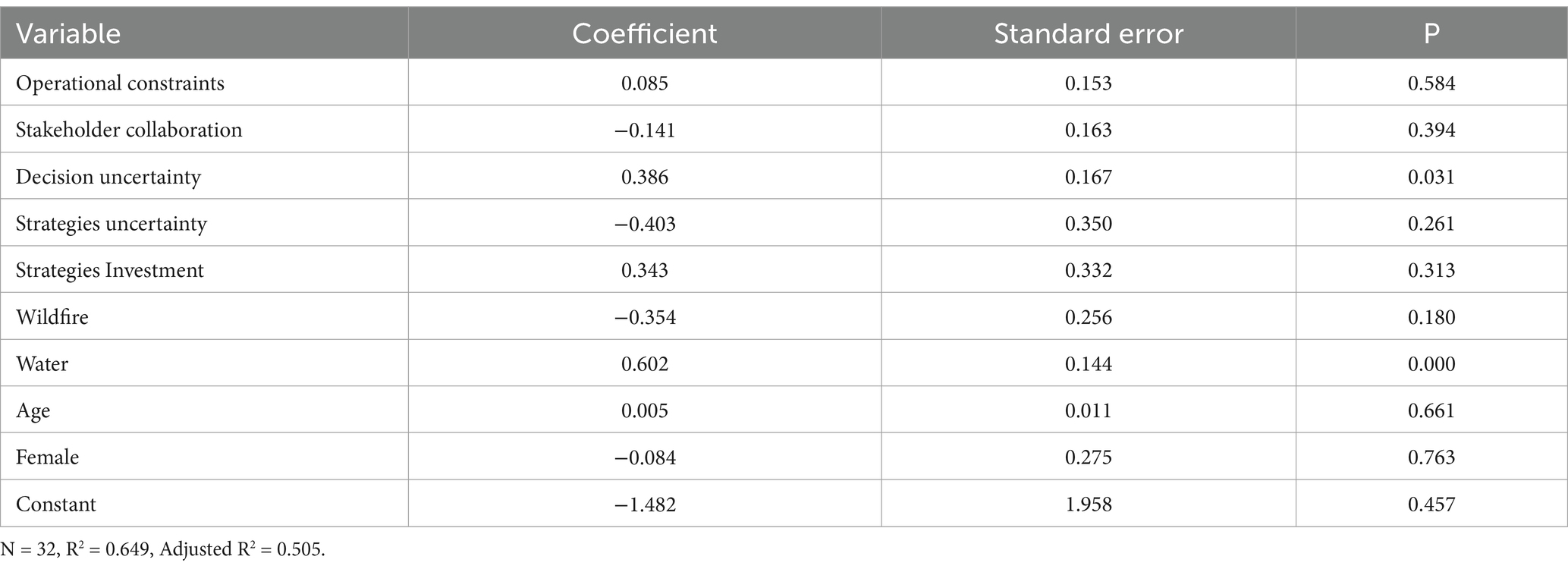
Table 8. Regression analysis of factors predicting the importance of reasons to invest in forest restoration (Investment motivation).
4 Discussion
The study identifies key barriers and uncertainties affecting investment in forested watershed restoration in California, highlighting operational, financial, and stakeholder-related challenges through survey responses and Factor Analysis. These findings provide insights into the factors limiting restoration efforts while also informing strategies to mitigate uncertainties and improve investment confidence. Understanding the interplay between financial constraints, regulatory complexities, and stakeholder coordination allows for the development of targeted approaches that enhance restoration feasibility.
4.1 Reasons to invest in forest restoration treatments
Survey results highlighted key motivations for investing in forest restoration, with environmental benefits emerging as the most critical factor, particularly in terms of biodiversity conservation, air and water quality improvement, and carbon sequestration for climate mitigation (Burton and Macdonald, 2011; Crouzeilles et al., 2016; Spake et al., 2015). Additionally, reducing wildfire risks was a highly prioritized concern, reflecting the urgency of preventing destructive fires that threaten ecosystems and communities (Zhang and Wei, 2013). Water supply protection was also a major investment driver, reinforcing the essential role of forested watersheds in maintaining water quality and availability (Wu et al., 2011; Sun et al., 2015). While social and economic benefits were acknowledged, responses indicated that stakeholders place greater emphasis on ecological and immediate risk-reduction outcomes, though economic considerations remain relevant (Yuan et al., 2019). Factor Analysis further confirmed these findings, revealing that while environmental, social, and economic outcomes are interrelated, wildfire risk reduction and water supply protection stand out as distinct investment priorities.
4.2 Barriers to investing in restoring forested watersheds
The survey identified several key barriers to investing in forested watershed restoration, with financial constraints—particularly the high costs of treatments and rising implementation expenses—emerging as a primary concern. Operational limitations, such as shortened work windows due to snow or wildfire and restricted workforce capacity, further hinder project execution. Stakeholder and communication challenges, including a lack of trust, resistance to changing management practices, and limited awareness of the co-benefits of fuels treatments, also pose significant obstacles (Mandarano and Paulsen, 2011). Additionally, the prioritization of wildfire risk reduction, as revealed through Factor Analysis, reflects the growing urgency of addressing fire-related threats in the face of climate change (Zhang and Wei, 2013).
4.3 Relevance of uncertainties in decision making
Uncertainties such as the financial return of water-related benefits and the availability of credible data emerged as significant factors influencing investment decisions. These findings align with previous research that emphasizes the importance of understanding economic returns and having reliable data for decision-making (Allan et al., 2012). Climate change was also recognized as a relevant factor, highlighting the necessity of incorporating climate considerations into restoration planning (de Groot et al., 2013). The need for further work after completing a project and understanding innovative financing were other notable uncertainties, suggesting that stakeholders are aware of the ongoing nature of restoration efforts and the need for effective funding mechanisms (Goldstein et al., 2008).
4.4 Importance of strategies for dealing with uncertainties
Securing sufficient funding is essential for effective forest restoration, with respondents emphasizing the value of treating restoration as an infrastructure investment to attract financial support and long-term commitment (Liang et al., 2018). While Meli et al. (2017) primarily focus on ecological benefits, the financial implications of restoration remain a key consideration. Capitalizing restoration costs may offer tax advantages to landowners by allowing deductions against future revenues generated from ecosystem services (Christmann et al., 2025; Polasky et al., 2010). Payments for ecosystem services (PES), such as carbon sequestration credits and water quality incentives, provide financial compensation for maintaining ecological functions. Additionally, improved land productivity and sustainable timber harvesting may yield further economic returns, while enhanced environmental conditions can increase property values, making restoration investments financially viable upon land transactions (Underwood et al., 2017). Aligning restoration initiatives with financial incentives can encourage greater participation and investment from landowners (Tedesco et al., 2022; Evans et al., 2022).
Beyond financial aspects, quantifying the co-benefits of fuels treatments and increasing access to reliable data are crucial for informed decision-making and investment confidence (Fujii et al., 2017). Transparent reporting and credible data improve stakeholder understanding of restoration benefits, fostering greater support among investors and policymakers (Busch and Mukherjee, 2017). Stakeholder engagement and adaptive management are also essential for addressing uncertainties and improving restoration success. Effective collaboration among local communities, landowners, and relevant stakeholders builds trust and facilitates alignment on restoration priorities (Jones et al., 2017). Adaptive management, which involves continuous monitoring and refinement of strategies based on evolving environmental conditions, enhances long-term project resilience (Paletto et al., 2021). Integrating financial stability, data transparency, and stakeholder coordination is critical for ensuring the sustainability and success of forest restoration efforts (Crouzeilles et al., 2017).
4.5 Relevance of strategies for increasing investments
The survey highlighted the relevance of various strategies for increasing investments in forested watershed restoration. Access to sufficient funds was again underscored as the most important strategy. Treating forest restoration as an infrastructure investment that can be capitalized and better quantifying the co-benefits of fuels treatments were also highly relevant (Meli et al., 2017). Improving the availability of credible data and information for making informed investment decisions was another key strategy, aligning with findings that highlight the necessity of reliable data (Jalonen et al., 2017).
4.6 Correlations and regression analysis
The correlation and regression analyses provide insights into the factors influencing investment decisions in forested watershed restoration. Results emphasize the significance of addressing both financial and operational constraints, alongside stakeholder engagement and communication strategies, to enhance investment confidence (Brancalion et al., 2019; Crouzeilles et al., 2019). The regression analysis highlights the role of uncertainty management in investment motivations, indicating that securing sufficient funding and improving data availability are key to overcoming barriers (Valente et al., 2017). Operational constraints, including access to skilled labor and technical expertise, also impact investment decisions, while effective stakeholder collaboration fosters shared priorities and supports long-term project success (Ren et al., 2017). Additionally, the availability of credible data and transparent reporting mechanisms is essential for building trust among investors and stakeholders (Guo et al., 2019).
Further analysis underscores the importance of reducing uncertainties related to financial returns and climate change impacts, as investors are more likely to commit resources when expected outcomes are well understood (Crouzeilles et al., 2016). The integration of multiple criteria in decision making—considering ecological, economic, and social dimensions—emerges as a critical strategy for prioritizing restoration efforts (Zhou et al., 2022). These findings suggest that improving financial security, regulatory clarity, and data-driven decision-making can collectively enhance restoration investment feasibility.
4.7 Implications for policy and practice
The findings of this study signify numerous critical implications for policy and practice concerning forested watershed restoration in California. Firstly, there is an indispensable need for effective communication of the multifaceted benefits of forest restoration. Policymakers should emphasize strategies that highlight not only the environmental advantages such as biodiversity conservation and improved water quality (Sun et al., 2015), but also the social and economic benefits, including job creation and sustainable resource management (Schultz et al., 2016). Comprehensive communication can cultivate widespread support for restoration projects, ultimately leading to enhanced community engagement and public investment.
Moreover, the results suggest that stakeholders are particularly motivated by the potential for wildfire risk reduction and the safeguarding of water supplies. Thus, targeted strategies that underscore these priorities are likely to resonate more profoundly with stakeholders, increasing their dedication to restoration initiatives (Bryant et al., 2023). Innovative funding mechanisms, such as payments for ecosystem services (PES), can play a crucial role in this context. By framing restoration efforts as vital infrastructure investments, stakeholders may attract potential investors who recognize the importance of forests in climate resilience and ecosystem services (Chen et al., 2014). These economic perspectives are crucial as the allocation of funds directly impacts the scale and effectiveness of restoration efforts.
Securing flexible funding mechanisms is vital, as financial uncertainties can deter potential investments in restoration projects. The implementation of PES and public-private partnerships not only provides financial incentives but also helps mitigate risks associated with restoration endeavors (Tedesco et al., 2022). A comprehensive approach that highlights the ecological and economic benefits of restoration can bolster stakeholder confidence, ultimately fostering an environment conducive to investment. Additionally, improving data accessibility and credibility is essential for addressing uncertainties that influence investment decisions. Stakeholders require reliable information regarding the ecological and economic benefits of restoration, allowing for more informed decision-making (Meli et al., 2017; Morgan et al., 2023).
Finally, the substantial potential of forest restoration for carbon sequestration presents a compelling justification for investment. Communicating this role effectively in the broader context of climate change mitigation can create a more supportive atmosphere for forested watershed restoration initiatives (Guizar-Coutiño et al., 2022). Collectively, these insights demonstrate the importance of integrating various strategies within policy frameworks to enhance investment in California’s forested watersheds. Such measures will ensure their resilience and sustainability, ultimately supporting the ecological, economic, and social well-being of communities that rely on these critical ecosystems.
Data availability statement
The original contributions presented in the study are included in the article/supplementary material, further inquiries can be directed to the corresponding author.
Author contributions
LA: Conceptualization, Data curation, Formal analysis, Methodology, Writing – original draft, Writing – review & editing. LP: Conceptualization, Funding acquisition, Methodology, Project administration, Supervision, Writing – original draft, Writing – review & editing. ME: Conceptualization, Data curation, Formal analysis, Methodology, Writing – original draft, Writing – review & editing. BE: Conceptualization, Methodology, Supervision, Writing – original draft, Writing – review & editing. RB: Conceptualization, Formal analysis, Funding acquisition, Methodology, Project administration, Supervision, Visualization, Writing – original draft, Writing – review & editing.
Funding
The author(s) declare that financial support was received for the research and/or publication of this article. This study was financially supported by the NSF EAGER grant (Grant no: NSF 2122174).
Conflict of interest
The authors declare that the research was conducted in the absence of any commercial or financial relationships that could be construed as a potential conflict of interest.
Generative AI statement
The authors declare that no Gen AI was used in the creation of this manuscript.
Publisher’s note
All claims expressed in this article are solely those of the authors and do not necessarily represent those of their affiliated organizations, or those of the publisher, the editors and the reviewers. Any product that may be evaluated in this article, or claim that may be made by its manufacturer, is not guaranteed or endorsed by the publisher.
Supplementary material
The Supplementary material for this article can be found online at: https://www.frontiersin.org/articles/10.3389/ffgc.2025.1587763/full#supplementary-material
References
Akhtar, N., Ishak, M. I. S., Bhawani, S. A., and Umar, K. (2021). Various natural and anthropogenic factors responsible for water quality degradation: a review. Water 13:2660. doi: 10.3390/w13192660
Allan, J., McIntyre, P., Smith, S., Halpern, B., Boyer, G., Buchsbaum, A., et al. (2012). Joint analysis of stressors and ecosystem services to enhance restoration effectiveness. Proc. Natl. Acad. Sci. 110, 372–377. doi: 10.1073/pnas.1213841110
Amatya, D. M., and Trettin, C. C. (2020). Long-term ecohydrologic monitoring: a case study from the Santee experimental forest, South Carolina. J South Carolina Water Resour 6, 46–55. doi: 10.34068/jscwr.06.05
Barros, A., Ager, A., Day, M., Krawchuk, M., and Spies, T. (2018). Wildfires managed for restoration enhance ecological resilience. Ecosphere 9:2161. doi: 10.1002/ecs2.2161
Bart, R., Safeeq, M., Wagenbrenner, J., and Hunsaker, C. (2020). Do fuel treatments decrease forest mortality or increase streamflow? A case study from the Sierra Nevada (USA). Ecohydrology 14:2254. doi: 10.1002/eco.2254
Bismihayati, B. (2023). Watershed management through sustainable development concept: literature review. Sci. Environ. J. Postgrad. 5, 77–82. doi: 10.24036/senjop.v5i2.186
Brancalion, P. H. S., Niamir, A., Broadbent, E., Crouzeilles, R., Barros, F., Zambrano, A., et al. (2019). Global restoration opportunities in tropical rainforest landscapes. Science. Advances 5:aav3223. doi: 10.1126/sciadv.aav3223
Bryant, B., Maurer, T., Saksa, P., Herman, J., Wilson, K., and Smith, E. (2023). Exploring interacting effects of forest restoration on wildfire risk, hydropower, and environmental flows. Sustain. For. 15:11549. doi: 10.3390/su151511549
Burnett, K., Ticktin, T., Bremer, L., Quazi, S., Geslani, C., Wada, C. A., et al. (2018). Restoring to the future: environmental, cultural, and management trade-offs in historical versus hybrid restoration of a highly modified ecosystem. Conserv. Lett. 12:12606. doi: 10.1111/conl.12606
Burton, P., and Macdonald, S. (2011). The restorative imperative: challenges, objectives and approaches to restoring naturalness in forests. Silva Fennica 45:74. doi: 10.14214/sf.74
Busch, J., and Mukherjee, A. (2017). Encouraging state governments to protect and restore forests using ecological fiscal transfers: India's tax revenue distribution reform. Conserv. Lett. 11:12416. doi: 10.1111/conl.12416
Chen, X., Viña, A., Shortridge, A., An, L., and Liu, J. (2014). Assessing the effectiveness of payments for ecosystem services: an agent-based modeling approach. Ecol. Soc. 19:107. doi: 10.5751/es-05578-190107
Christmann, T., Cjuno-Turpo, I., López-Aranda, M., Wilson, S., Cuní-Sanchez, A., Malhi, Y., et al. (2025). ‘Sowing and harvesting water’: revisiting forest restoration in the Peruvian Andes through a multi-stakeholder analysis. People Nat. 7, 631–652. doi: 10.1002/pan3.10787
Crouzeilles, R., Barros, F. S. M., Molin, P. G., Ferreira, M. S., Junqueira, A. B., Chazdon, R. L., et al. (2019). A new approach to map landscape variation in forest restoration success in tropical and temperate forest biomes. J. Appl. Ecol. 56, 2675–2686. doi: 10.1111/1365-2664.13501
Crouzeilles, R., Curran, M., Ferreira, M., Lindenmayer, D., Grelle, C., and Benayas, J. (2016). A global meta-analysis on the ecological drivers of forest restoration success. Nature. Communications 7:666. doi: 10.1038/ncomms11666
Crouzeilles, R., Ferreira, M., Chazdon, R., Lindenmayer, D., Sansevero, J., Monteiro, L., et al. (2017). Ecological restoration success is higher for natural regeneration than for active restoration in tropical forests. Science. Advances 3:345. doi: 10.1126/sciadv.1701345
de Groot, R., Blignaut, J., Ploeg, S., Aronson, J., Elmqvist, T., and Farley, J. (2013). Benefits of investing in ecosystem restoration. Conserv. Biol. 27, 1286–1293. doi: 10.1111/cobi.12158
Eales, J., Haddaway, N., Bernes, C., Cooke, S., Jonsson, B., Kouki, J., et al. (2016). What is the effect of prescribed burning in temperate and boreal forest on biodiversity, beyond tree regeneration, pyrophilous and saproxylic species? A systematic review protocol. Environ. Evid. 5:19. doi: 10.1186/s13750-016-0076-5
East, A., Logan, J., Dartnell, P., Lieber-Kotz, O., Cavagnaro, D., McCoy, S., et al. (2021). Watershed sediment yield following the 2018 Carr fire, Whiskeytown National Recreation Area, northern California. Earth and space. Science 8:828. doi: 10.1029/2021ea001828
Ellison, D., Futter, M. N., and Bishop, K. (2012). On the forest cover-water yield debate: from demand-to supply-side thinking. Glob. Chang. Biol. 18, 806–820. doi: 10.1111/j.1365-2486.2011.02589.x
Ellisson, D., Morris, C. E., Locatelli, B., Sheil, D., et al. (2017). Trees, forests and water: cool insights for a hot world. Glob. Environ. Chang. 43, 51–61. doi: 10.1016/j.gloenvcha.2017.01.002
Eriksson, M., Safeeq, M., Egoh, B., Pathak, T., Lugg, J., O'Geen, A., et al. (2025). The potential of collaborative solutions to improve management of California (United States) wildlands. Restor. Ecol. 33:e14330. doi: 10.1111/rec.14330
Evans, K., Meli, P., Zamora-Cristales, R., Schweizer, D., Méndez-Toribio, M., Gómez-Ruíz, P., et al. (2022). Drivers of success in collaborative monitoring in forest landscape restoration: an indicative assessment from Latin America. Restor. Ecol. 31:13803. doi: 10.1111/rec.13803
Fujii, H., Satō, M., and Managi, S. (2017). Decomposition analysis of forest ecosystem services values. Sustain. For. 9:687. doi: 10.3390/su9050687
Ganzlin, P., Gundale, M., Becknell, R., and Cleveland, C. (2016). Forest restoration treatments have subtle long-term effects on soil C and N cycling in mixed conifer forests. Ecol. Appl. 26, 1503–1516. doi: 10.1002/15-1100
Giles-Hansen, K., Wei, X., and Hou, Y. (2021). Dramatic increase in water use efficiency with cumulative forest disturbance at the large forested watershed scale. Carbon Balance Manag. 16:6. doi: 10.1186/s13021-021-00169-4
Goldstein, J., Pejchar, L., and Daily, G. (2008). Using return-on-investment to guide restoration: a case study from Hawaii. Conserv. Lett. 1, 236–243. doi: 10.1111/j.1755-263x.2008.00031.x
Guariguata, M., and Brancalion, P. (2014). Current challenges and perspectives for governing forest restoration. Forests 5, 3022–3030. doi: 10.3390/f5123022
Guizar-Coutiño, A., Jones, J., Balmford, A., Carmenta, R., and Coomes, D. (2022). A global evaluation of the effectiveness of voluntary REDD+ projects at reducing deforestation and degradation in the moist tropics. Conserv. Biol. 36:e13970. doi: 10.1111/cobi.13970
Guo, H., Goulden, M., Chung, M. G., Nyelele, C., Egoh, B., Keske, C., et al. (2023). Valuing the benefits of forest restoration on enhancing hydropower and water supply in California's Sierra Nevada. Sci. Total Environ. 876:162836. doi: 10.1016/j.scitotenv.2023.162836
Guo, Y., Hou, L., Zhang, Z., Zhang, J., Cheng, J., Wei, G., et al. (2019). Soil microbial diversity during 30 years of grassland restoration on the loess plateau, China: tight linkages with plant diversity. Land Degrad. Dev. 30, 1172–1182. doi: 10.1002/ldr.3300
Hair, J. F., and Sarstedt, M. (2019). A primer on partial least squares structural equation modeling (PLS-SEM). 2nd Edn. Cham: Sage Publications.
Hessburg, P., Prichard, S., Hagmann, R., Povak, N., and Lake, F. (2021). Wildfire and climate change adaptation of western north American forests: a case for intentional management. Ecol. Appl. 31:e02432. doi: 10.1002/eap.2432
Jalonen, R., Valette, M., Boshier, D., Duminil, J., and Thomas, E. (2017). Forest and landscape restoration severely constrained by a lack of attention to the quantity and quality of tree seed: insights from a global survey. Conserv. Lett. 11:424. doi: 10.1111/conl.12424
Jones, G., Keane, J., Gutiérrez, R., and Peery, M. (2017). Declining old-forest species as a legacy of large trees lost. Divers. Distrib. 24, 341–351. doi: 10.1111/ddi.12682
Jones, G., Keyser, A., Westerling, A., Baldwin, W., Keane, J., Sawyer, S., et al. (2021). Forest restoration limits megafires and supports species conservation under climate change. Front. Ecol. Environ. 20, 210–216. doi: 10.1002/fee.2450
Ku, P., Tsz-Ki, M., Uzun, H., Chen, H., Dahlgren, R. A., Hoang, T. C., et al. (2024). Dominance of particulate mercury in stream transport and rapid watershed recovery from wildfires in northern California, USA. Environ. Sci. Technol. 58, 22159–22169. doi: 10.1021/acs.est.4c09364
Lamb, D. (2018). Undertaking large-scale forest restoration to generate ecosystem services. Restor. Ecol. 26, 657–666. doi: 10.1111/rec.12706
Layton, K., and Ellison, D. (2016). Induced precipitation recycling (IPR): a proposed concept for increasing precipitation through natural vegetation feedback mechanisms. Atmos. Chem. Phys. 91, 553–565. doi: 10.1016/j.ecoleng.2016.02.031
Li, Q., Wei, X., Zhang, M., Liu, W., Giles-Hansen, K., and Wang, Y. (2018). The cumulative effects of forest disturbance and climate variability on streamflow components in a large forest-dominated watershed. J. Hydrol. 557, 448–459. doi: 10.1016/j.jhydrol.2017.12.056
Liang, S., Hurteau, M., and Westerling, A. (2018). Large-scale restoration increases carbon stability under projected climate and wildfire regimes. Front. Ecol. Environ. 16, 207–212. doi: 10.1002/fee.1791
Mandarano, L., and Paulsen, K. (2011). Governance capacity in collaborative watershed partnerships: evidence from the Philadelphia region. J. Environ. Plan. Manag. 54, 1293–1313. doi: 10.1080/09640568.2011.572694
Maridi, M., Agustina, P., and Saputra, A. (2014). Vegetation analysis of Samin watershed, Central Java as water and soil conservation efforts. Biodiver. J. Biol. Divers. 15:214. doi: 10.13057/biodiv/d150214
Meli, P., Ellison, D., Ferraz, S., Filoso, S., and Brancalion, P. H. S. (2024). On the unique value of forests for water: hydrologic impacts of forest disturbances, conversion, and restoration. Glob. Chang. Biol. 30:e17162. doi: 10.1111/gcb.17162
Meli, P., Holl, K., Benayas, J., Jones, H., Jones, P., Montoya, D., et al. (2017). A global review of past land use, climate, and active vs. passive restoration effects on forest recovery. PLoS One 12:e0171368. doi: 10.1371/journal.pone.0171368
Merriam, E., Petty, J., and Strager, M. (2016). Watershed planning within a quantitative scenario analysis framework. J. Vis. Exp. 113:54095. doi: 10.3791/54095-v
Morgan, M., Webster, A., Piccarello, M., Jones, K., Chermak, J., McCarthy, L., et al. (2023). Adaptive governance strategies to address wildfire and watershed resilience in New Mexico's upper Rio Grande watershed. Front. Climate 5:1062320. doi: 10.3389/fclim.2023.1062320
North, M. P., York, R. A., Collins, B. M., Hurteau, M. D., Jones, G. M., Knapp, E. E., et al. (2021). Pyrosilviculture needed for landscape resilience of dry western United States forests. Journal of Forestry, 119, 520–544. doi: 10.1093/jofore/fvab026
Page-Dumroese, D., Busse, M., Archuleta, J., McAvoy, D., and Roussel, É. (2017). Methods to reduce forest residue volume after timber harvesting and produce black carbon. Scientifica 2017, 1–8. doi: 10.1155/2017/2745764
Paletto, A., Báliková, K., and Meo, I. (2021). Opinions towards the water-related payments for ecosystem services (pes) schemes: the stakeholders’ point of view. Water Environ. J. 35, 1051–1062. doi: 10.1111/wej.12697
Polasky, S., Nelson, E., Pennington, D., and Johnson, K. (2010). The impact of land-use change on ecosystem services, biodiversity and returns to landowners: a case study in the state of Minnesota. Environ. Resour. Econ. 48, 219–242. doi: 10.1007/s10640-010-9407-0
Prepas, E. E., Putz, G., Smith, D., Burke, J. M., and MacDonald, J. D. (2008). The FORWARD project: objectives, framework and initial integration into a detailed forest management plan in Alberta. For. Chron. 84, 330–337. doi: 10.5558/tfc84330-3
Ramberg, E., Berglund, H., Penttilä, R., Strengbom, J., and Jönsson, M. (2023). Prescribed fire is an effective restoration measure for increasing boreal fungal diversity. Ecol. Appl. 33:e2892. doi: 10.1002/eap.2892
Ren, Y., Lü, Y., Fu, B., and Zhang, K. (2017). Biodiversity and ecosystem functional enhancement by forest restoration: a meta-analysis in China. Land Degrad. Dev. 28, 2062–2073. doi: 10.1002/ldr.2728
Ryu, S., Choi, H., Lim, J., Lee, I., and Ahn, Y. (2017). Post-fire restoration plan for sustainable forest management in South Korea. Forests 8:188. doi: 10.3390/f8060188
Saksa, P., Safeeq, M., and Dymond, S. (2017). Recent patterns in climate, vegetation, and forest water use in California montane watersheds. Forests 8:278. doi: 10.3390/f8080278
Schultz, C., Mattor, K., and Moseley, C. (2016). Aligning policies to support forest restoration and promote organizational change. Forest Policy Econ. 73, 195–203. doi: 10.1016/j.forpol.2016.09.015
Spake, R., Ezard, T., Martin, P., Newton, A., and Doncaster, C. (2015). A meta-analysis of functional group responses to forest recovery outside of the tropics. Conserv. Biol. 29, 1695–1703. doi: 10.1111/cobi.12548
Srivastava, L., Hand, M., Kim, J., Sánchez, J., Lupi, F., Garnache, C., et al. (2020). How will climate change affect the provision and value of water from public lands in southern California through the 21st century? Agric. Resour. Econ. Rev. 49, 117–149. doi: 10.1017/age.2020.3
Steel, Z., Jones, G., Collins, B., Green, R., Koltunov, A., Purcell, K., et al. (2022). Mega-disturbances cause rapid decline of mature conifer forest habitat in California. Ecol. Appl. 33:e2763. doi: 10.1002/eap.2763
Stephens, S., Foster, D., Battles, J., Bernal, A., Collins, B., Hedges, R., et al. (2023). Forest restoration and fuels reduction work: different pathways for achieving success in the Sierra Nevada. Ecol. Appl. 34:e2932. doi: 10.1002/eap.2932
Sun, G., Caldwell, P., and McNulty, S. (2015). Modelling the potential role of forest thinning in maintaining water supplies under a changing climate across the conterminous United States. Hydrol. Process. 29, 5016–5030. doi: 10.1002/hyp.10469
Sun, G., and Vose, J. (2016). Forest management challenges for sustaining water resources in the Anthropocene. Forests 7:68. doi: 10.3390/f7030068
Tang, X., and Adesina, J. (2022). Integrated watershed management framework and groundwater resources in Africa—a review of West Africa sub-region. Water 14:288. doi: 10.3390/w14030288
Tedesco, A., Brancalion, P., Hepburn, M., Walji, K., Wilson, K., Possingham, H., et al. (2022). The role of incentive mechanisms in promoting forest restoration. Philos. Trans. R. Soc. B Biol. Sci. 378:20210088. doi: 10.1098/rstb.2021.0088
Underwood, E., Hutchinson, R., Viers, J., Rodd, K., Distler, T., and Marty, J. (2017). Quantifying trade-offs among ecosystem services, biodiversity, and agricultural returns in an agriculturally dominated landscape under future land-management scenarios. San Francisco estuary and watershed. Science 15:sfews.2017v15iss2art4. doi: 10.15447/sfews.2017v15iss2art4
Valente, R., de Souza Petean, F., and Vettorazzi, C. (2017). Multicriteria decision analysis for prioritizing areas for forest restoration. Cerne 23, 53–60. doi: 10.1590/01047760201723012258
Vogler, K., Ager, A., Day, M., Jennings, M., and Bailey, J. (2015). Prioritization of forest restoration projects: tradeoffs between wildfire protection, ecological restoration and economic objectives. Forests 6, 4403–4420. doi: 10.3390/f6124375
Walsh, C. J., Fletcher, T. D., and Burns, M. J. (2012). Urban stormwater runoff: a new class of environmental flow problem. PLoS One 7:e45814. doi: 10.1371/journal.pone.0045814
Won, S., and Song, Y. (2024). Assessment of temperate deciduous forest communities and structures after restoration through the multi-reference ecosystems framework. Forests 15:597. doi: 10.3390/f15040597
Wu, T., Kim, Y., and Hurteau, M. (2011). Investing in natural capital: using economic incentives to overcome barriers to forest restoration. Restor. Ecol. 19, 441–445. doi: 10.1111/j.1526-100x.2011.00788.x
Yuan, W. G., Zheng, J.-W., Gu, J.-C., and Lu, G.-Q. (2019). Responses of forest eco-service values to biotopes in the China’s Conversion of Cropland to Forest Program. Environ Earth Sci 78:147. doi: 10.1007/s12665-019-8166-7
Zhang, M., and Wei, X. (2013). Alteration of flow regimes caused by large-scale forest disturbance: a case study from a large watershed in the interior of British Columbia. Canada. Ecohydrology 7, 544–556. doi: 10.1002/eco.1374
Keywords: forested watersheds, restoration, California, investments, climate change mitigation
Citation: Ayompe LM, Padilla L, Eriksson M, Egoh BN and Bales RC (2025) Overcoming barriers and uncertainties to investing in forested watershed restoration in California. Front. For. Glob. Change. 8:1587763. doi: 10.3389/ffgc.2025.1587763
Edited by:
Ana Cristina Gonçalves, University of Evora, PortugalReviewed by:
Davide De Battisti, University of Padua, ItalyDavid Ellison, University of Bern, Switzerland
Pete Bettinger, University of Georgia, United States
Copyright © 2025 Ayompe, Padilla, Eriksson, Egoh and Bales. This is an open-access article distributed under the terms of the Creative Commons Attribution License (CC BY). The use, distribution or reproduction in other forums is permitted, provided the original author(s) and the copyright owner(s) are credited and that the original publication in this journal is cited, in accordance with accepted academic practice. No use, distribution or reproduction is permitted which does not comply with these terms.
*Correspondence: Lacour Mody Ayompe, bWxhY291ckB1Y2kuZWR1
 Lacour Mody Ayompe
Lacour Mody Ayompe Lace Padilla2
Lace Padilla2 Roger C. Bales
Roger C. Bales